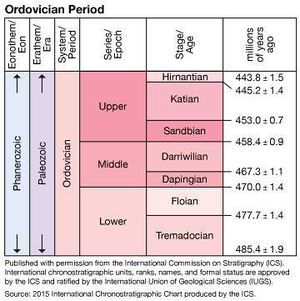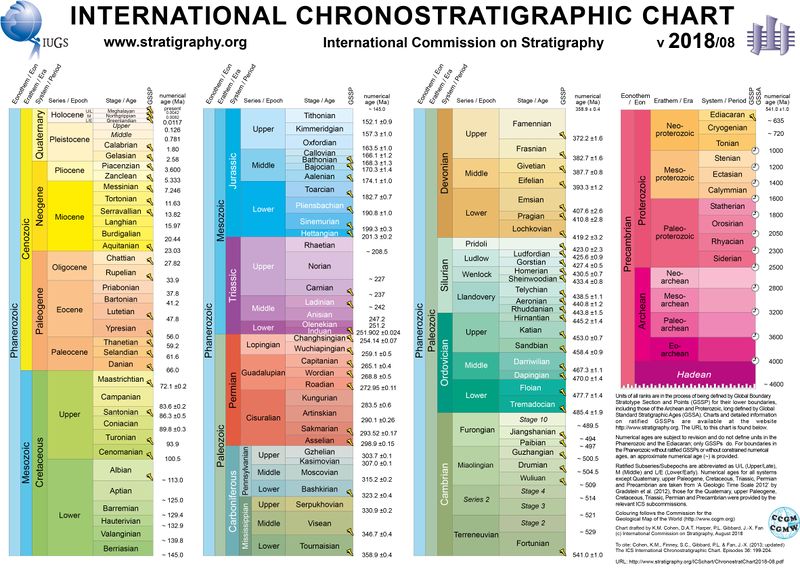Ordovician

The Ordovician was the second geological period of the Paleozoic era, extending from approximately 485.4 million to 443.8 million years ago. It is divided into Upper, Middle, and Lower epochs(Figure 1).[2] This period is named after a northern Welsh tribe, the Ordovices. The name was first used by Dr. Charles Lapworth, an English geologist, in 1879.[3]
Rapid and sustained biodiversification occurred throughout the Ordovician. The biodiversification during this period is sometimes referred to as the "Great Ordovician Biodiversification Event".[3] Marine fauna and flora became more varied (Figure 2). Invertebrates were especially successful at diversifying at this time, particularly trilobites. There is some evidence that the first terrestrial plants may have developed in the Ordovician and the first mixed aquatic and land fauna may have also occurred. The oldest, fully vertebrate fossils in the geologic record appear at this time. The end of the Ordovician was marked by the Ordovician-Silurian extinction event, a mass extinction where a large number of species died off (Figure 3).[4]
-
Figure 2. Ordovician diorama at Washington's National Museum of Natural History.[5]
-
Figure 3. Fossiliferous limestone slab from the Liberty Formation (Upper Ordovician) of Caesar Creek State Park.[6]
Tectonic shifts during the Ordovician led to the supercontinent of Gondwana, the largest landmass at the time, moving towards the South Pole. Sea level fluctuated greatly during the Ordovician, rising and dropping throughout the period, occasionally flooding land areas and creating shallow inland seas. Gondwana moved far enough south by the Upper, or late, Ordovician, that a major glaciation occurred.[4] The glaciation led to sea level dropping, as the forming land ice took up ocean water, and also led to climate fluctuations. This glaciation is thought to be a major contributing cause to the Ordovican-Silurian extinction event.[3]

For Further Reading
- Geologic time scale
- Geologic period
- Glaciation
- Plate tectonics
- Stratigraphy
- Or explore a random page
References
- ↑ International Commission on Stratigraphy."International Chronostratigraphic Chart v2015" Accessed Nov.8, 2018 [Online]. Available: https://www.britannica.com/science/Fortunian-Stage/media/1554753/133054
- ↑ 2.0 2.1 International Commission on Stratigraphy."International Chronostratigraphic Chart v2018" Accessed Nov.8, 2018 [Online]. Available: http://www.stratigraphy.org/index.php/ics-chart-timescale
- ↑ 3.0 3.1 3.2 Gradstein, F. M. "The Geologic Time Scale 2012". Volume 2. 1st ed. Amsterdam ; Boston: Elsevier, 2012.
- ↑ 4.0 4.1 University of California, Museum of Paleontology."The Ordovician Period" Accessed Nov.12, 2018 [Online]. Available: http://www.ucmp.berkeley.edu/ordovician/ordovician.php
- ↑ WikiMedia Commons."File:Nmnh fg09.jpg" Accessed Nov.16, 2018 [Online]. Available: https://en.wikipedia.org/wiki/File:Nmnh_fg09.jpg
- ↑ WikiMedia Commons."File:LibertyFormationSlab092313.jpg" Accessed Nov.16, 2018 [Online]. Available: https://en.wikipedia.org/wiki/File:LibertyFormationSlab092313.jpg


![Figure 2. Ordovician diorama at Washington's National Museum of Natural History.[5]](/wiki/images/thumb/0/0a/Ordo_dio.jpg/673px-Ordo_dio.jpg)
![Figure 3. Fossiliferous limestone slab from the Liberty Formation (Upper Ordovician) of Caesar Creek State Park.[6]](/wiki/images/thumb/6/67/LibertyFormationSlab092313.jpg/544px-LibertyFormationSlab092313.jpg)